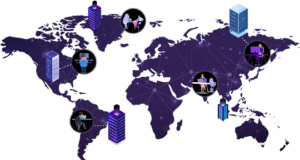Top 8 Benefits Of Using Cloud Technologies In The Banking Sector
The banking sector is increasingly turning to cloud technology to help them meet the demands of the digital age. By using cloud services, financial institutions can take advantage of cloud technology's scalability, security, and cost-effectiveness. Additionally, these cloud providers offer a wide range of services and features that can be used to meet the specific needs of the banking sector, such as compliance and security. This article will discuss cloud technologies' benefits to the banking sector or any other financial organization.
Benefits that the Banking Sector gets from using Cloud Technologies#

Cloud technology in banking offers many benefits to banking and other financial institutions. Here are the top 8 benefits of using cloud computing in the banking sector:
Increased flexibility and scalability:#
Cloud technology in banking allows banks to scale their infrastructure and services up or down as needed. This is particularly beneficial for banks that experience seasonal fluctuations in demand or need to accommodate sudden spikes in traffic.
Reduced costs:#
Cloud technology in banking can help banks reduce costs by eliminating the need for expensive hardware and software. Banks can also reduce costs by using pay-as-you-go pricing models, which allow them to only pay for the resources they use.
Improved security:#
Cloud providers typically invest heavily in security, offering banks a higher level of security than they could achieve. Many cloud providers also offer compliance with various security standards, such as SOC 2 and PCI DSS.
Increased agility:#
Cloud technology allows banks to quickly and easily launch new services and applications, which can help them stay ahead of the competition.
Improved disaster recovery:#
Cloud computing in banking allows banks to quickly and easily recover from disasters, such as natural disasters or cyber-attacks. Banks can use cloud-based disaster recovery solutions to keep critical systems and data safe and accessible.
Better collaboration and communication:#
Cloud computing in banking can help banks improve collaboration and communication between different departments and teams. This can lead to more efficient processes and better decision-making.
Increased access to data and analytics:#
Cloud computing in banking can provide banks with easy access to large amounts of data and analytics, which can help them make more informed decisions.
Better customer experience:#
Banks can improve the customer experience by using cloud technology by offering new and innovative services, such as mobile banking, online account management, and real-time notifications.
Hence, cloud computing in finance is increasing day by day. Not only can they get all these benefits but also other financial organizations that employ cloud computing in the finance system get the same benefits.
Cloud service models#
Cloud service models refer to the different types of cloud computing services offered to customers. These models include:
Infrastructure as a Service (IaaS):#
This model provides customers with virtualized computing resources, such as servers, storage, and networking, over the internet. Examples of IaaS providers include Amazon Web Services (AWS), Microsoft Azure, and Google Cloud Platform (GCP).
Platform as a Service (PaaS):#
This model provides customers with a platform for developing, running, and managing applications without the complexity of building and maintaining the underlying infrastructure. Examples of PaaS providers include AWS Elastic Beanstalk, Azure App Service, and GCP App Engine.
Software as a Service (SaaS):#
This model provides customers access to software applications over the internet. Examples of SaaS providers include Salesforce, Microsoft Office 365, and Google G Suite.
Function as a Service (FaaS):#
This model allows customers to execute code in response to specific events, such as changes to data in a database or the arrival of new data in a stream, without having to provision and manage the underlying infrastructure. Examples of FaaS providers include AWS Lambda, Azure Functions, and Google Cloud Functions.
Backup as a Service (BaaS):#
This model allows customers to back up their data to cloud storage. Examples of BaaS providers include AWS Backup, Azure Backup, and Google Cloud Backup.
Each model provides different benefits and is suited to different workloads and use cases.
Which cloud technology is used more in the Banking sector#
The banking sector has been using cloud technology for several years now, with many financial institutions recognizing the benefits that it can bring. A variety of different cloud technologies are used in the banking sector, but some of the most popular include Amazon Web Services (AWS), Microsoft Azure, and Google Cloud Platform (GCP).
Amazon Web Services (AWS)#
Amazon Web Services (AWS) is one of the banking sector's most widely used cloud technologies. This is largely due to its scalability, security, and cost-effectiveness. AWS offers a wide range of services, including computing, storage, and databases, which can be easily scaled up or down to meet the changing needs of the business. Additionally, AWS has several security features that can be used to protect sensitive financial data, including encryption, access controls, and network security.
Microsoft Azure#
Microsoft Azure is another popular cloud technology used in the banking sector. Azure offers similar services to AWS, including computing, storage, and databases, but it also has several additional features that are particularly useful for the banking sector. For example, Azure's Active Directory can be used to manage user access and authentication, and its Azure Key Vault can securely store and manage encryption keys. Additionally, Azure's compliance certifications can help financial institutions meet regulatory requirements.
Google Cloud Platform (GCP)#
Google Cloud Platform (GCP) is a widely used cloud computing in the banking sector. GCP offers services similar to those provided by AWS and Azure, including computing, storage, and databases. Additionally, GCP provides several security and compliance features, such as encryption and access controls, that can be used to protect financial data. GCP is also known for its machine learning and big data analytics capabilities, which can be used to gain insights from financial data.
In addition to these major cloud providers, several other cloud computing in the banking sector are used. For example, some financial institutions use private clouds or hybrid clouds to provide a more secure and compliant environment for their data.
Conclusion#
Cloud computing in finance offers many benefits for banks and other financial institutions. From increased flexibility and scalability to improved security and customer experience, cloud technology can help banks stay ahead of the competition and provide better customer service. As more and more banks adopt cloud technology, it will become increasingly important for banks to stay up-to-date with the latest cloud technologies to remain competitive.







